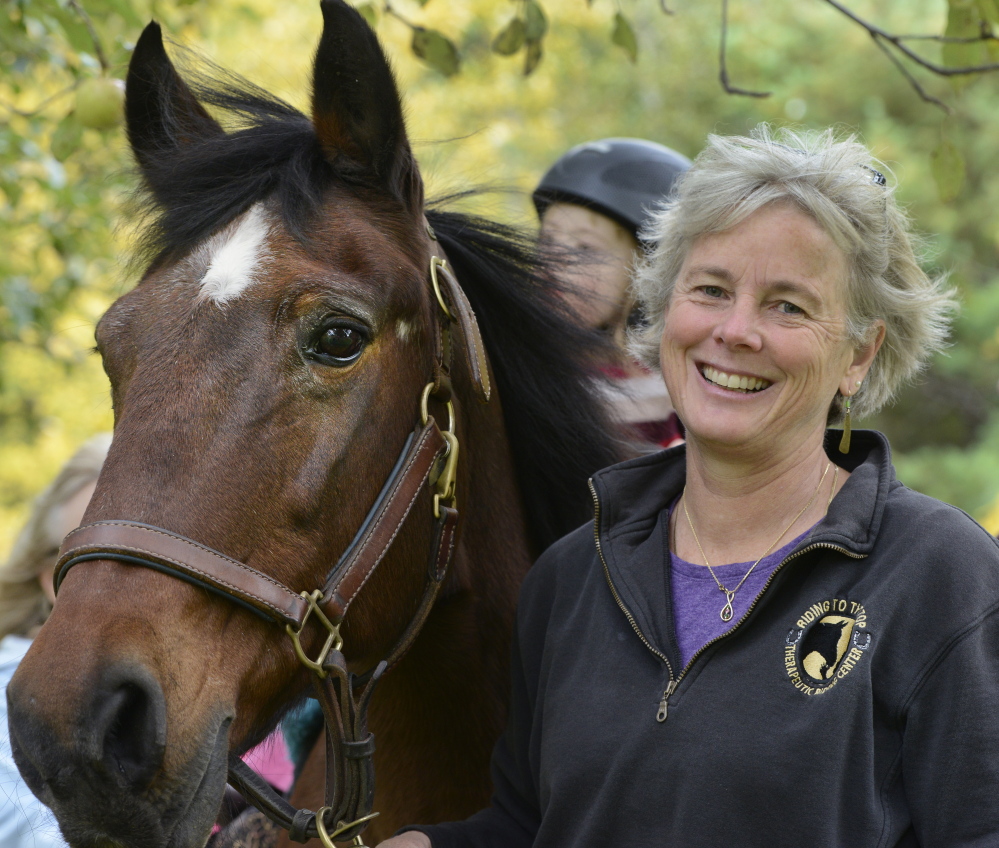WINDHAM — In the last 20 years, Sarah Bronson has seen her therapeutic riding center go from a rented-out space to a 50-acre facility with an indoor rink and as many as 3,000 clinics a year.
She’s also seen students who started there as young children with physical or mental disabilities go on to college. In one instance, a young man with Asperger syndrome developed the confidence and physical ability, as well as the passion for animals, to go on to veterinarian school.
Bronson, the executive director at Riding to the Top Therapeutic Riding Center in Windham, is happy enough with the large number of clinics, the more than 60 active volunteers, and the wide reach the center has today.
But after a riding clinic she gave to a 3-year-old girl with Down syndrome last week, Bronson smiled and said she wants more.
Riding to the Top has been going strong for a long time, but how did it evolve?
It was started in 1993 and we bought this property in 1998. We kept outgrowing the commercial riding centers where we were renting. There is only so much time they can allow you. We bought this farm in 1998 and we got the indoor arena up in 2005. We finished our capital campaign and added office space in 2008. The indoor rink can be heated to 45 degrees, which is healthy for horses. We started the capital campaign in 2001 and in six years raised $1.6 million. Then the first year with the indoor rink, we doubled our client visits to 3,000 visits. The indoor arena has been pretty significant.
How has it changed Riding to the Top?
We finally could offer some consistency to the clients and horses. When you are making progress with a client and then have to take seven months off, the riders come back and you have to start over. And that first winter, the horses were like, ‘This is our vacation.’ They get used to the breaks, and then when you start them you have to start working with them again to get them ready. Now we give them breaks throughout the year. And the volunteers would go volunteer somewhere else and we’d have to recruit them back.
How many volunteers do you have?
We have 100 pretty consistent volunteers, and any week 60 to 70 who are helping. They’re passionate. The fellow out there, Dan, I said to him once you work like this is your full-time job, and he said: ‘I have a full-time job.’
What is the range of disabilities you work with here at the center?
It’s soup to nuts. When it started I was a physical therapist on the founding board and I worked with another physical therapist treating severe cognitive and physical disabilities because of our experience. We’ve since expanded to include people with hidden disabilities, like veterans; people suffering from alcohol and substance abuse; and kids at risk, who are involved with criminal activity and who are in transition in their lives. We still serve clients who have severe cognitive disabilities, like cerebral palsy and those with brain injuries. There is a wide range. Our oldest rider is 80; we had a child in here who is 3. Some of the veterans served in the Korean War, so they’re getting older.
You’ve started working with veterans more recently?
Yes, veterans with post-traumatic stress syndrome, to help give them a sense of belonging in the community. They might not see themselves as disabled, but they have heightened anxiety and are trying to assimilate back into our lives and to their lives after a very, very horrific experience. It’s hard to come back and feel at peace. That’s one thing the horses do. As therapists, one thing that’s important for us to remember is to be silent, to let (the vets) have that time with the horses, let them bond with the horses. As instructors we’re so used to talking, but sometime to let the veterans find their way, it’s better to let them have time alone with the horses.
Where would you like the center to evolve to?
We are working on that (now), trying to think of big out-of-the-box things. I would like to expand the veterans program more. And I hope to include families more into the whole process. We had a ride-a-thon with mothers and fathers who never get to do things with their kids as a family. We are trying to find ways to make this very open and accepting, to make sure families are more involved. Despite the number of people we serve here we don’t always connect the families with their children, some who have autism or Down syndrome. To be a resource that helps in that way, those are things I dream about.
How many lessons do you give a week?
Riding to the Top sees on average 90 clients per week for lessons; the vast majority are therapeutic riding lessons to help those with neuromuscular impairment. A small number of riders, such as veterans, come for equine-assisted learning that allows clients to form a relationship with a horse.
Send questions/comments to the editors.




Success. Please wait for the page to reload. If the page does not reload within 5 seconds, please refresh the page.
Enter your email and password to access comments.
Hi, to comment on stories you must . This profile is in addition to your subscription and website login.
Already have a commenting profile? .
Invalid username/password.
Please check your email to confirm and complete your registration.
Only subscribers are eligible to post comments. Please subscribe or login first for digital access. Here’s why.
Use the form below to reset your password. When you've submitted your account email, we will send an email with a reset code.